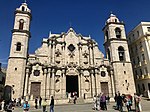Gran Teatro de La Habana
1910s establishments in Cuba20th-century architecture in CubaArchitecture in CubaConcert halls in CubaNeoclassical architecture in Cuba ... and 4 more
Opera houses in CubaSpanish Colonial architecture in CubaTheatres completed in 1915Theatres in Havana

Gran Teatro de La Habana is a theater in Havana, Cuba, home to the Cuban National Ballet. It was designed by the Belgian architect Paul Belau and built by Purdy and Henderson, Engineers in 1914 at the site of the former Teatro Tacón. Its construction was paid for by the Galician immigrants of Havana to serve as a community-social center. Located in the Paseo del Prado, its facilities include theatres, a concert hall, conference rooms, a video screening room, as well as an art gallery, a choral center and several rehearsal halls for dance companies. It hosts the International Ballet Festival of Havana every two years since 1960.
Excerpt from the Wikipedia article Gran Teatro de La Habana (License: CC BY-SA 3.0, Authors, Images).Gran Teatro de La Habana
Paseo de Martí (Paseo del Prado), Havana
Geographical coordinates (GPS) Address External links Nearby Places Show on map
Geographical coordinates (GPS)
| Latitude | Longitude |
|---|---|
| N 23.1369 ° | E -82.3594 ° |
Address
Gran Teatro de La Habana
Paseo de Martí (Paseo del Prado)
10000 Havana (Prado)
Havana, Cuba
Open on Google Maps











